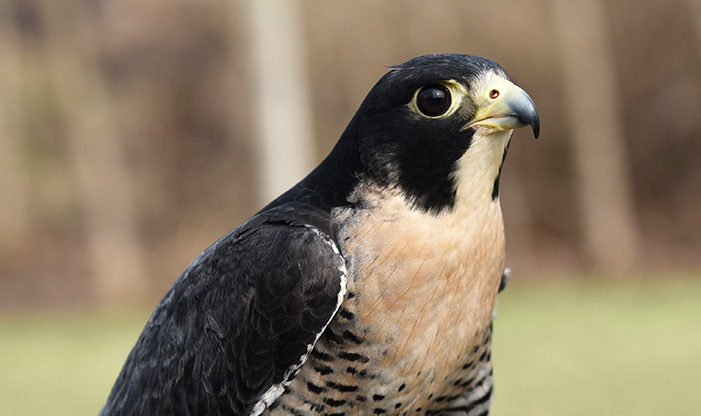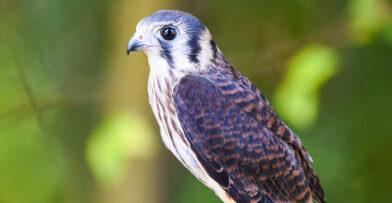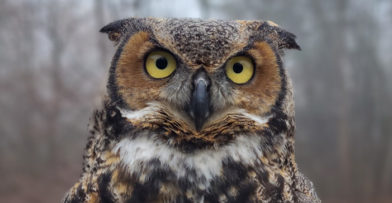Earlier this year, Schlitz Audubon Nature Center welcomed a new addition to our Raptor Program: Otis, a Peregrine Falcon. Hatched in the wild in 2013, Otis arrived at Raptor Education Group, Inc (REGI) in Antigo, WI as a juvenile with a severe left-wing injury. Wildlife rehabilitators at REGI believe that he collided with a phone wire mid-flight causing acute damage.
Otis underwent surgery to repair his injuries, but the wing did not heal properly on its own, causing him to permanently lose his ability for strong flight. Otis was deemed non-releasable to the wild and remained at REGI as an educational bird until early 2020. Last year, he moved into the Wildlife in Need Center in Oconomowoc, WI to continue his work as an educational ambassador. With a strong collaboration between Schlitz Audubon’s Raptor Program and the Wildlife in Need Center, the decision was made to transfer Otis to us, and we are grateful for the wonderful opportunity to bring him into our program.
Characteristics of the Peregrine Falcon
Peregrine Falcons are one of the largest falcon species found in the United States, weighing in at an average of 2 1/2 pounds with a 3 1/2-foot wingspan. Adults have a dark, blue-grey head and feathers with a lighter, barred chest. Their slate grey wings and tail are built for aerodynamics and are long, stiff, and sharply pointed. These birds are fierce aerial predators and are most famous for their incredible speed, claiming a top diving speed of 240 mph. As a mid-flight hunter, Peregrine Falcons prefer perching and nesting on tall structures such as cliffs, bluffs, and skyscrapers where they can scan the horizon for their prey. The majority of their diet consists of small to medium-sized birds such as ducks, pigeons, and starlings.
Conservation Status of Peregrine Falcons
Peregrine Falcons have been listed as an endangered species in the state of Wisconsin since 1975. Their species was at risk for many years due to poisoning from a pesticide called DDT which caused their eggshells to weaken and break. The use of DDT has since been banned in the United States and their populations have slowly increased over the past few decades thanks to the integral implementation of nest boxes across the state. Companies such as We Energies have supported Peregrine Falcon populations by building nest boxes in their power plants, which act as ideal nesting sites due to their tall structure. We Energies began their program to help Peregrines in the early 1990s, and today their nest sites in Wisconsin have produced 388 of these birds.
Peregrine Falcons at the Center
In support of our mission, our Raptor Program aims to provide meaningful experiences and environmental awareness to all with the help of the birds in our care. Our Peregrine Falcon ambassadors serve as strong symbols of Peregrine conservation in our state, bringing awareness to the environmental threats to this endangered species.
Our program received its first federal education permits in 1983, allowing us to care for these magnificent birds and share their stories. We welcomed our first Peregrine, Cliff, in 1999 and have since had the honor of educating about this species. Four amazing Peregrines have been a part of the Raptor Program over the years, and our newest ambassador Otis will carry on our mission.
We are proud of our partnership with We Energies, who support our environmental education programs. In 2006, we were invited to participate at We Energies Energy Park at the Wisconsin State Fair and continue to present there every August. Our Peregrine, as well as other birds, meets the public and we share information about conservation efforts and the work that We Energies does for the species. They also sponsor our onsite Raptor Saturday programs, that occur most first Saturdays of the month.
In our Raptor Program, Otis will continue our long-standing history of Peregrine Falcon education. We look forward to sharing him with you!


